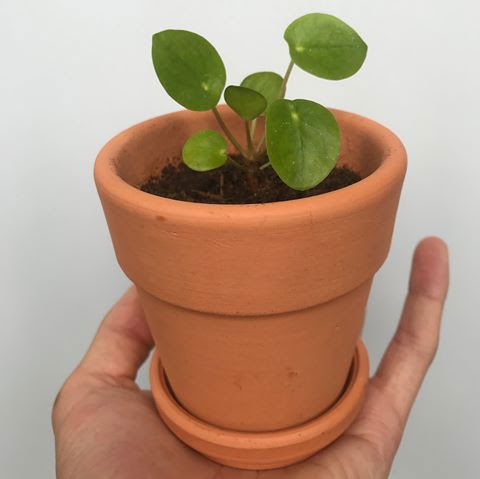
Pilea peperomioides
Contents
- Top Tips
- Location, Water, Humidity & Fertilisation
- Common Issues
- Origins, Temperature, Propagation, Repotting & Toxicity.
Are you struggling to find the answer to your specific plant issue? Book a 1-to-1 video call with THE HOUSEPLANT DOCTOR™, the website's friendly author, to overcome and address your niggling problem! Available on iMessage, WhatsApp, Facebook Messenger & more.
Top Tips & Info
- Care Difficulty - Easy
- Provide a bright location, avoiding more than two hours of direct sunlight or excessively dark settings.
- Water once the top third of the soil dries out, reducing this further in the autumn and winter months.
- Provide a good level of humidity by introducing a humidity/pebble tray to keep the surrounding moisture high whilst the heaters are operating. The use of artificial humidity is not needed in the spring and summer months.
- Fertilise using a 'Houseplant' labelled feed every four waters in the spring and summer, reducing this to every sixth water in the colder months.
- Regularly check for pests, most notably Mealybugs.
- Keep the ambient temperature above 12℃ (54℉) throughout the year, especially when placed outdoors in the summer. Flowers will appear in the spring if the previous winter temperatures are below 18℃ (64℉).
- Repot every two years in spring using a 'Houseplant' labelled potting mix - this is the perfect time to take stem or 'pup' cuttings to promote better growth.
- The name, 'peperomioides' can be translated to 'having the appearance of Peperomia', that refers to the similar characteristics between the two. The species, though, has never been classified in Peperomia, which continues to confuse amateur gardeners into believing it is part of the latter's genus!
Location & Light - 🔸🔸
Never allow a Pilea to endure strong sunlight all day as it'll lead to dehydration and veiny yellowed leaves. A location that offers bright, indirect sunlight with a small amounts of off-peak direct sunlight is highly recommended over the autumn and winter months. Remember - the amount of light and current season of the year will directly govern the frequencies of waters per month. Specimens placed in darker areas must be kept on the drier side to life, whereas brighter locations will require more soil moisture to lubricate photosynthesis.
Water - 🔸🔸
Allow the top third of the soil dry out in between irrigations, reducing this further in the autumn and winter to replicate their dormancy period. As their root systems are sensitive to temperature change, never apply cold water to avert weakening the plant's overall health. Under-watering symptoms include a loss of lower leaves, the yellowing or browning of foliage, deformed and stunted new growth. Over-watering symptoms include yellowed lower leaves, the curling of foliage and little to no growth. If your Pilea is losing its lower leaves quickly, root rot could be an issue, especially with those situated in dark locations. Click on this link to learn more about root rot and how to address it.
Humidity - 🔸🔸
Average room humidity is enough to occupy a Pilea, however, introduce a humidity tray whilst the radiators are operating to counteract the dry air.
Fertilisation - 🔸🔸
While using a 'Houseplant' labelled fertiliser, feed your plant once every four waters in the spring and summer before reducing this to every six in the colder months. Never directly apply a 'ready to pour' feed into the soil without a pre-water beforehand, as it may cause chemical root burn. Do not over-fertilise.
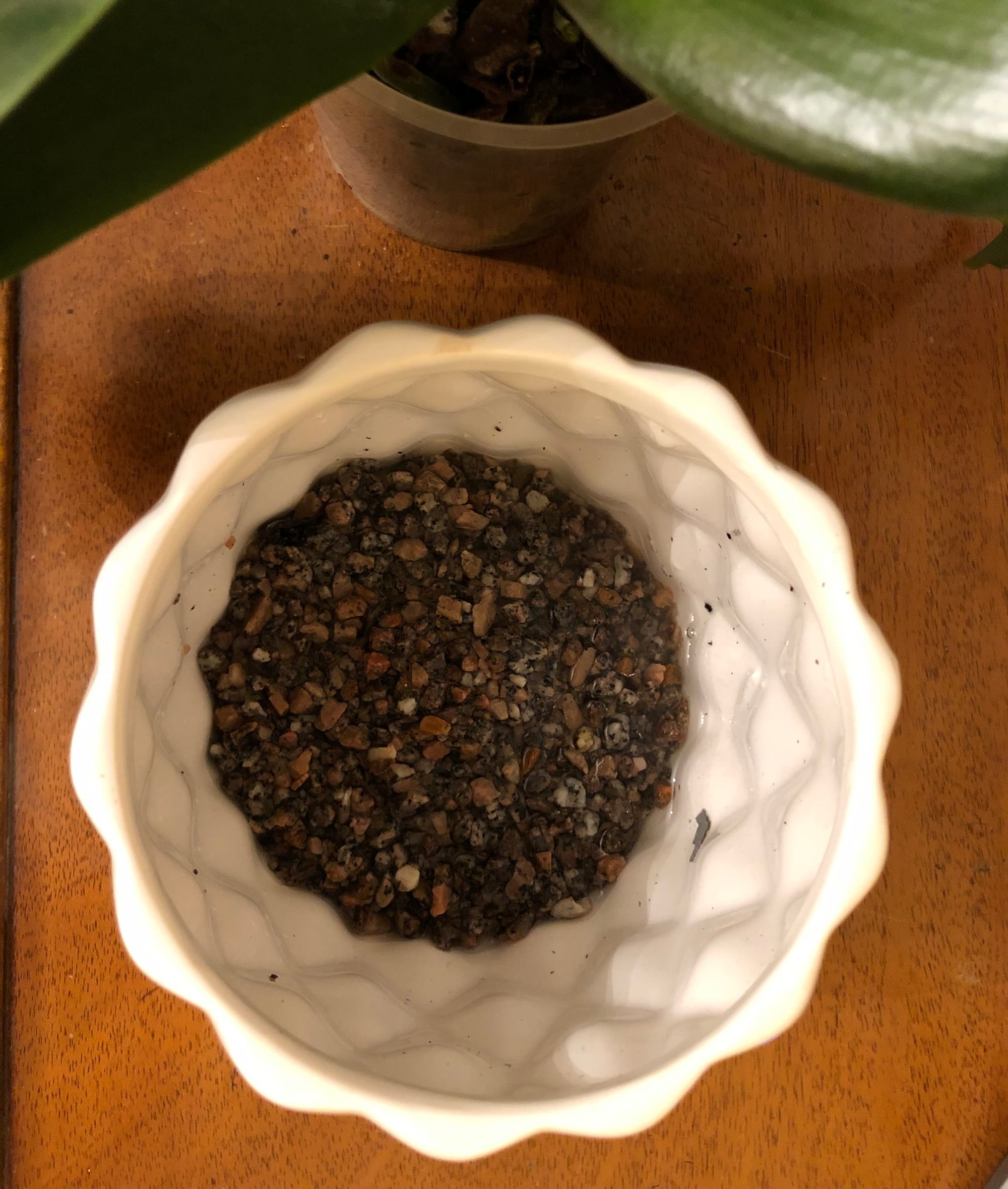 If you're forgetful with watering or battling with dry air, why not fill the decorative pot's bottom sixth with small grit? This will promote more reliable soil moisture that'll help encourage better growth & all-round health as the excess moisture will drain from the plant's plastic pot, thus creating a humid environment for root interaction.
If you're forgetful with watering or battling with dry air, why not fill the decorative pot's bottom sixth with small grit? This will promote more reliable soil moisture that'll help encourage better growth & all-round health as the excess moisture will drain from the plant's plastic pot, thus creating a humid environment for root interaction.
Common Issues with Pilea Peperomioides
If you can't find the answer to your specific houseplant problem, book a 1-to-1 video call with Joe Bagley to point you in the right direction today.
Green curling leaves symbolise over-watering, typically sped-up by too dark locations. Although root rot isn't overly common with Pilea, allow the top third of the soil to dry out in between irrigations to reduce the chance of this happening.
Too much sunlight will cause its leaves to yellow and curl over with elongated veins (pictured below). They'll never thrive in too much sun, so relocate your Pilea to a slightly darker location that offers a good level of indirect light. In some cases, its foliage may turn purple or red which is a common issue over the summer months when the sun is at its most sharpest.
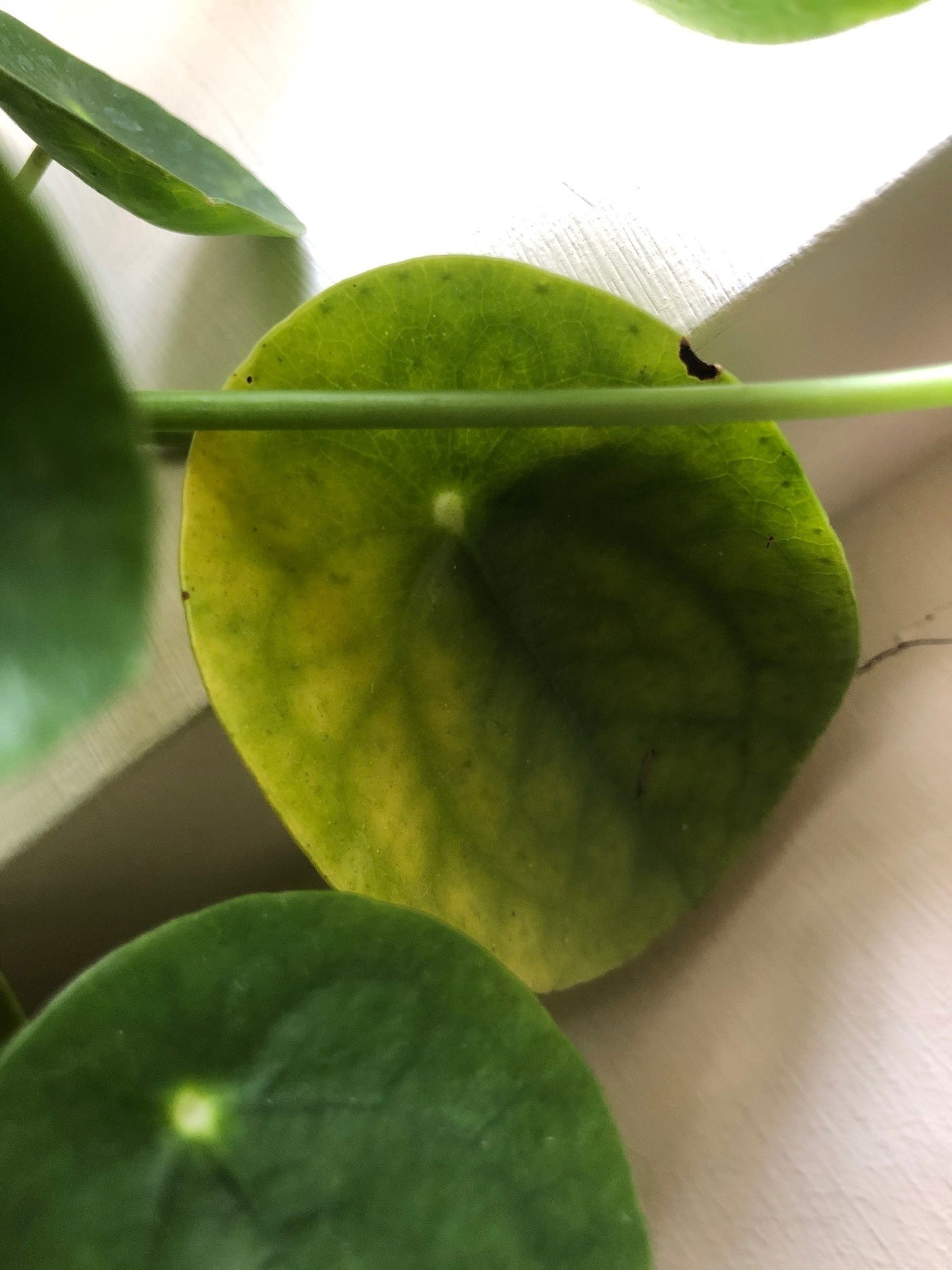 Prolonged Exposure to the Sunlight
Prolonged Exposure to the Sunlight
If the lower half of the leaves start to yellow and drop off, it could be due to either too little light, over-watering or poor air circulation which commonly all go hand in hand. Unfavourable growing conditions that aren't corrected will cause further damage to your Pilea and may spell the end of juvenile (pups) growth.
Rotting 'pups' is commonly down to too little light or over-watering. Although this may spell the end for less sturdy pups, new stem and rhizomatous growths will appear once the growing conditions are improved. Its rootball may need to be inspected for root rot; click here to learn about root rot.
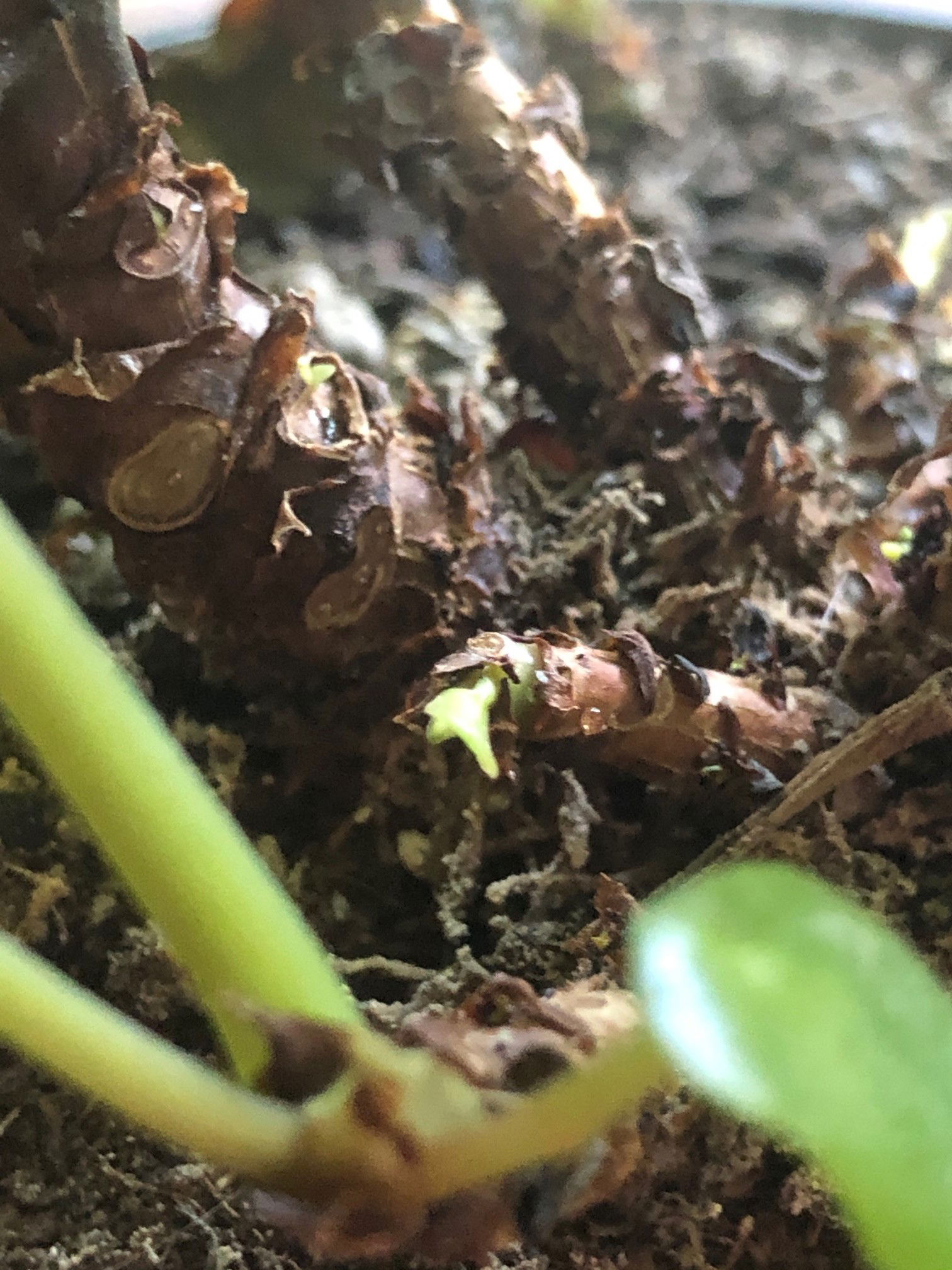 Crispy 'pups' on the other hand are the result of dehydration or too high temperatures.
Crispy 'pups' on the other hand are the result of dehydration or too high temperatures.
Failed propagated stem cuttings - There are several reasons why the cuttings haven't rooted well, including: the time of year (spring or summer is best), its size (Syngonium cuttings should have at least three leaves), poor growing conditions (replace water weekly for water-propagated cuttings, and avoid over-watering for soil-grown plants), and its growing environment (a bright sunless windowsill and warmth is important).
Small white dots that develop on the leaves' undersides are nothing to worry about and are the result of an imbalance of moisture between the leaves and roots. Although harmless, it's recommended to ease off with the waters slightly as the roots have absorbed too much water that can be transpired through the leaves. This process is called Oedema, and can affect many forms of succulents.
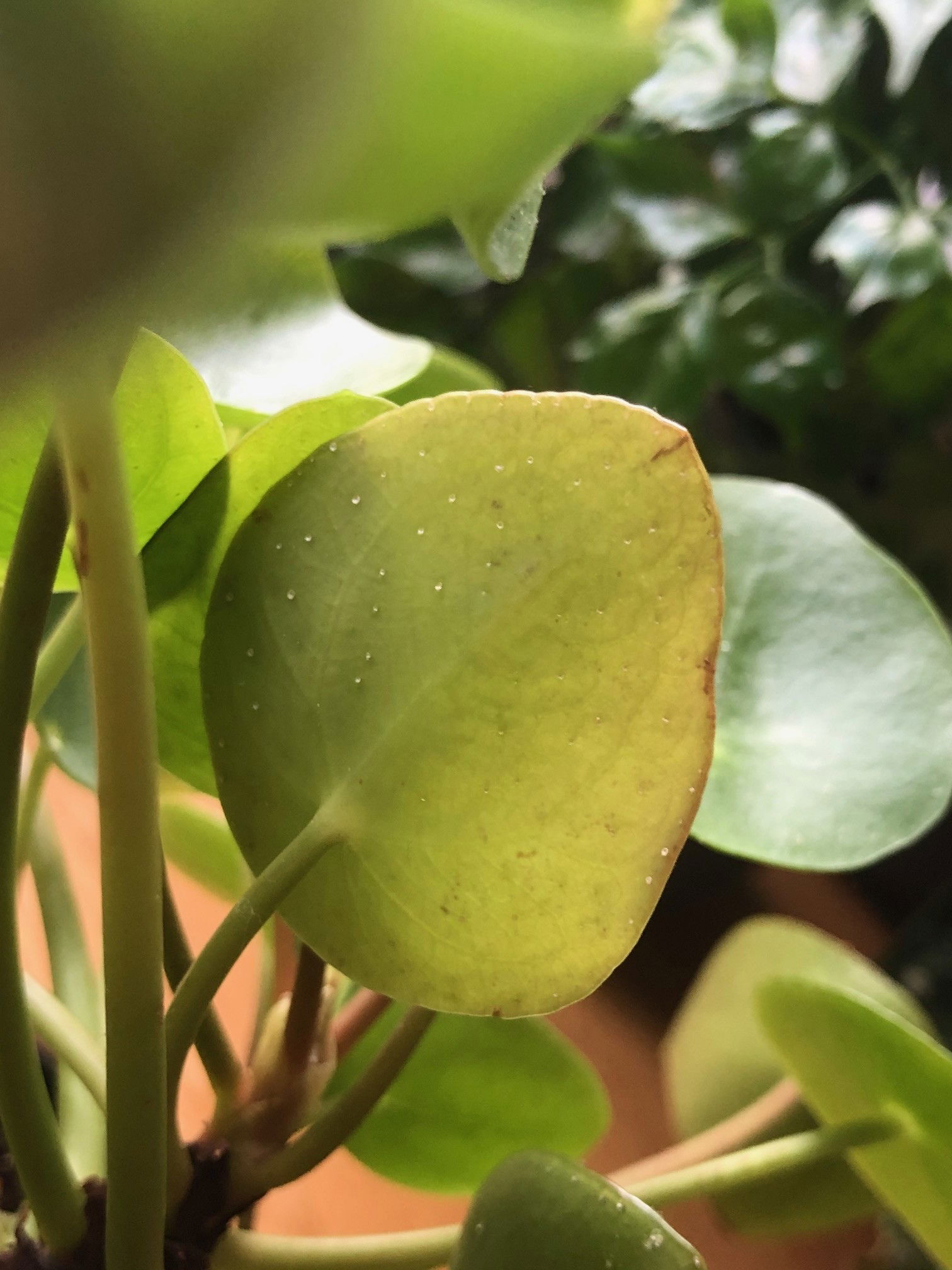 The small dots that appear on the leaves' undersides are caused by 'Oedema'.
The small dots that appear on the leaves' undersides are caused by 'Oedema'.
Origins
Although many believe that the species was brought back by Norwegian missionary, Agnar Espegren, from the Yunnan Province of southern China, it was in fact, Scottish explorer George Forrest who discovered the plant back in 1906 within the same region. Amateur botanists propagated Pilea without a formal binomial classification until the late 1980s, which is when the species was finally placed in the nettle family, Urticaceae. In the Chinese provinces of Yunnan and Sichuan, P. peperomioides naturally grow on damp rocks located in the nearby forests, but has recently become endangered due to a decline in numbers.
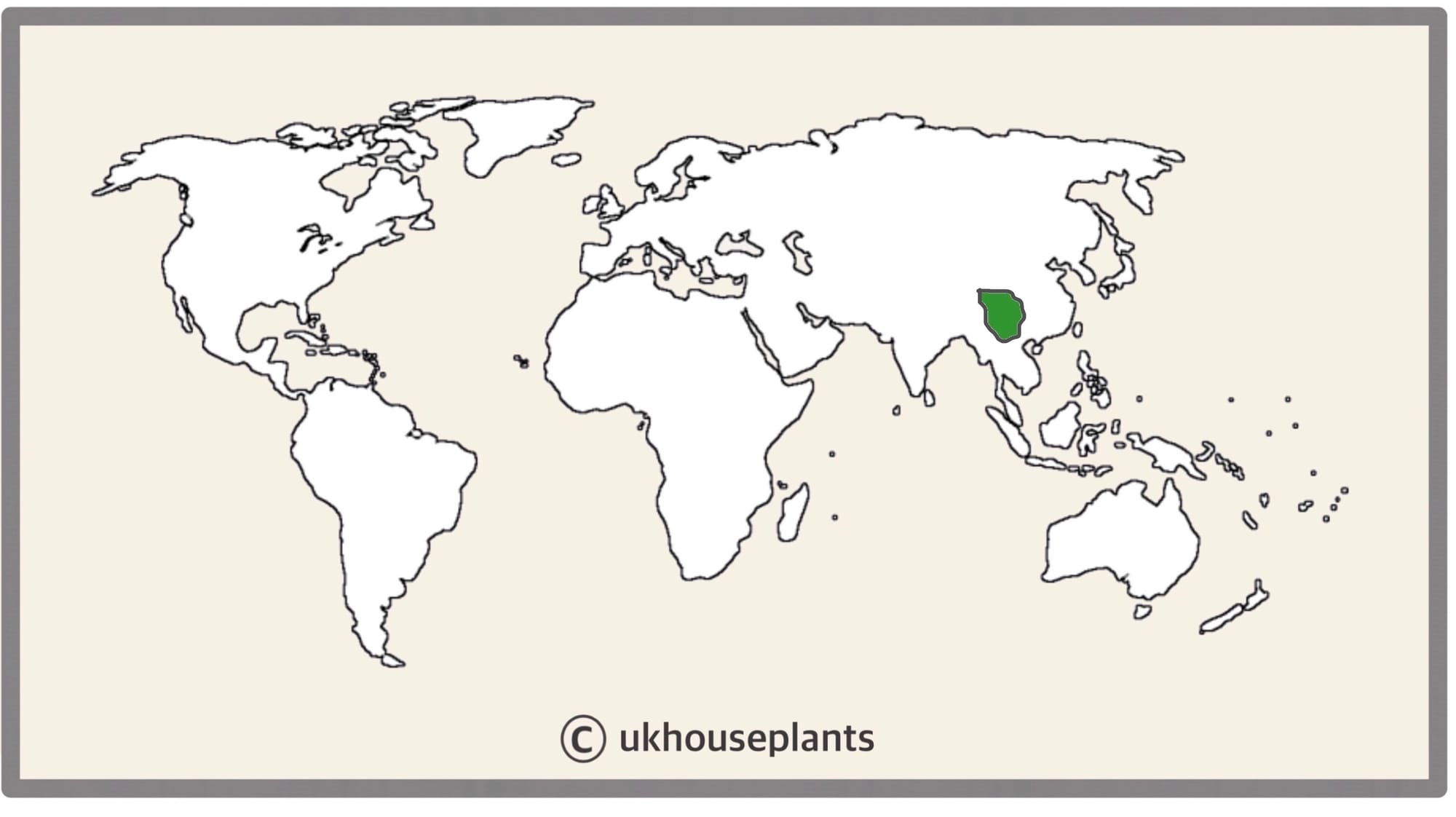 The Distribution of Pilea peperomioides
The Distribution of Pilea peperomioides
Temperature
12° - 24°C (54° - 75°F)
H1b (Hardiness Zone 12) - Can be grown outdoors during the summer in a sheltered location with temperatures above 12℃ (54℉), but is fine to remain indoors, too. If you decide to bring this plant outdoors, don't allow it to endure more than an hour of direct sunlight a day as it may result in sun-scorch. Regularly keep an eye out for pests, especially when re-introducing it back indoors.
Spread
Up to 0.4m in both height and width. The ultimate height will take between 5 - 10 years to achieve, with up to 6cm of stem growth being developed per season.
Pruning & Maintenance
Remove yellow or dying leaves, and plant debris to encourage better-growing conditions. While pruning, always use clean scissors or shears to reduce the chance of bacterial and fungal diseases. Never cut through yellowed tissue as this may cause further damage in the likes of diseases or bacterial infections. Remember to make clean incisions as too-damaged wounds may shock the plant, causing weakened growth and a decline in health.
Propagation
Via Seed, Stem Cuttings & 'Pup' (Basal Offests) Division.
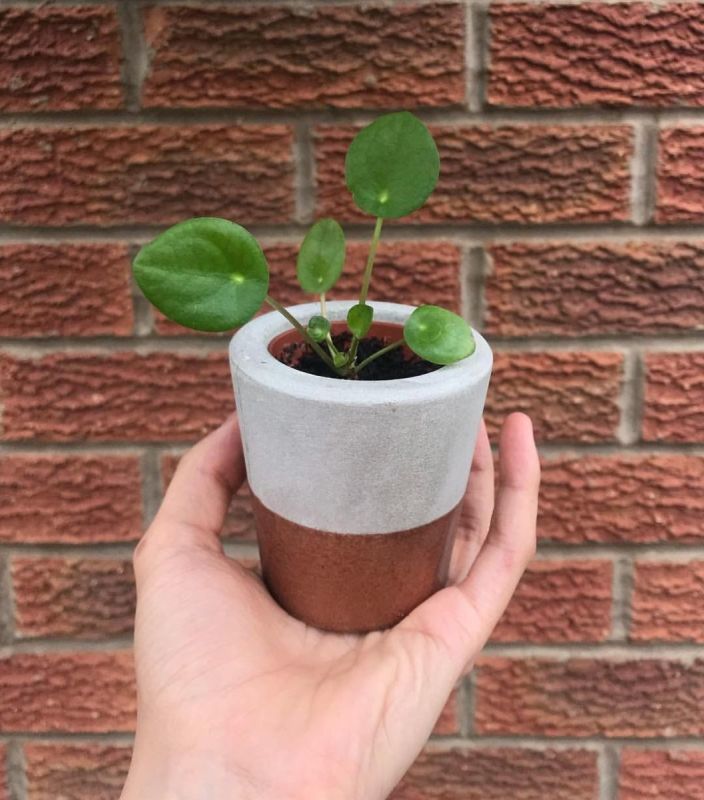
Stem Cuttings (Easy) - During the spring, slice back your Pilea shaft to promote bushier growth and more 'pups'. The best way to take stem cuttings is by using a clean pair of scissors and cutting off the top 8cm (3 inches) of stem. Immediately place the bottom half in lukewarm water for root development, providing a bright indirect setting for quicker growth. Small white roots should appear within a few days of propagation, and once they're 3cm (1.1 inches) in length, it can be potted up. 'Houseplant' compost is best, or you can make your own via using multipurpose compost with grit or perlite. Follow the care tips provided at the top of the article.
Pup (Basal Offset) Division (Very Easy) - Once the individual pups are around 5cm (2 inches) in length accompanied by a few healthy leaves, propagation can begin. Take the plant out of its pot and place your fingers in between the two plants; soil may have to be removed to get a better grip. While placing your hand close to the nodal junction, gently push the pup downwards, supporting the surrounding soil and mother plant. You should hear a snap. Cautiously separate the two roots systems, keeping great empathise in keeping them intact and damage-free. Immediately place the bottom half in lukewarm water for root development, providing a bright indirect setting for quicker growth. Small white roots should appear within a few days of propagation, and once they're 3cm (1.1 inches) in length, it can be potted up. Place the new plantlet in a well-draining potting mix, much similar to the original soil, and maintain the same care routines. 'Houseplant' compost is best, or you can make your own via using multipurpose compost with grit or perlite. Do NOT over-pot the new pup, as a ratio of roots-soil that leans towards the latter will cause root rot and inevitable death. Pups that are too small, or overly damaged will not root appropriately and therefore may rot. Follow the care tips provided at the top of the article, avoiding nearby radiators, prolonged droughts and direct sunlight for the first couple of months.
 Propagating your plant will create an adorable Pilea family.
Propagating your plant will create an adorable Pilea family.
Flowers
Small clusters of white flowers will appear midway down the stem and can last up to several days. This process usually gets underway in late spring, but some specimens can flower before, or after this time bracket. Although Pilea will bloom each year, the show is almost uninspiring and is often removed by horticulturalists so that the plant focuses its energy onto the foliage.
 The flowers of a P. peperomiodes are small, uninspiring and lay behind the foliage line.
The flowers of a P. peperomiodes are small, uninspiring and lay behind the foliage line.
Repotting
Repot every two years in the spring, using a 'Houseplant' labelled potting mix and the next sized pot with adequate drainage. Hydrate the plant 24hrs before the tinkering with the roots to prevent the risk of transplant shock. For those that are situated in a darker location, add a thin layer of small grit in the pot's base to improve drainage and downplay over-watering. Click here for a detailed step-by-step guide on transplantation, or via this link to learn about repotting with root rot.
Pests & Diseases
Keep an eye out for aphids, spider mites, mealybugs & scale. Common diseases associated with Pilea are root or stem rot, leaf-spot disease, powdery mildew and botrytis (grey mould) - click here for more information about how to identify and address any of these diseases.
Toxicity
This plant is classified as non-poisonous, but if large sections are eaten, vomiting, nausea and a loss of appetite may occur. Mass consumption should be dealt with quickly; acquire medical assistance for further information.
Retail Locations
Available via some garden centres or you can buy amateur cuttings on Facebook Market or Gumtree.
 Pilea peperomioides 'Crinkle Mojito'
Pilea peperomioides 'Crinkle Mojito'
Book a 1-to-1 Call with THE HOUSEPLANT DOCTOR™
If you need further advice with your houseplants, book an advice call with ukhouseplants' friendly and expert writer today! This can be done via a video or audio call on most apps, including Facebook, FaceTime & Skype. A ten-minute call costs £5.99 (US$7), or £15.99 for thirty minutes. You can ask multiple questions, including queries on plants, pests, terrariums, repotting advice and anything in between. Please consider supporting this service to keep ukhouseplants thriving!